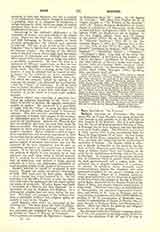

Badajoz, Diocese of (PACENSIS).—The Latin name Pax, or Civitas Pacensis, was given to this district because it was thought to be the Pax Julia or Pax Augusta of the Romans. But it is now certain that the Pax of the Roman period is the city of Beja, in Portugal, not far from Badajoz, and that the latter name is of Arabic origin. The bishopric was erected in 1225, shortly after it was reconquered from the Moors by King Alfonso IX of Leon. Its first bishop was Don Pedro Perez, appointed by Alfonso X, the Wise, and from that time it has had an uninterrupted succession of bishops. The diocese, which is suffragan to Seville, is bounded on the north by the Dioceses of Coria, Plasencia, and Toledo, on the east by those of Toledo, Ciudad Real, and Cordova, on the south by the Archdiocese of Seville, and on the west by Portugal. It is composed of 136 parishes, divided into 13 vicariates, which in ancient times numbered 18, with approximately half a million souls. The cathedral has a chapter composed of 5 prelates, 13 canons, 16 beneficed clerics (formerly called medioracioneros), besides the chaplains and other personnel necessary for the proper carrying out of Divine worship. There is a diocesan seminary, under good instructors, for the education of aspirants to the priesthood, also colleges in the city of Badajoz and in Zafra, conducted by the Regular Priests of the Heart of Mary, and several religious communities in other cities. The Poor Clares have an establishment at Almendrales; the discalced Franciscans, Carmelites, and Sisters of St. Anne at Badajoz, and the Augustinians, Carmelites, and Poor Clares elsewhere, making in all 19 communities of cloistered nuns, besides 3 communities of Sisters of Charity who attend the sick at Badajoz, Zafra, and Frenegal de la Sierra, There are schools for primary and religious instruction in all the parishes.
The diocesan territory of Badajoz comprises almost all of the civil province of the same name, which lies between the meridians 4° 36′ 12″ and 7° 9′ west of Greenwich, and between 37° 90′ and 39° 30′ north latitude, with an area of 7,143 square miles. Several rivers, among them the famous Guadiana (the Flumen Anas of the ancients), flow through this province, and the Madrid-Caceres-Lisbon railroad traverses it. All of this district is very fertile, and yields all kinds of cereals, wine, and oil, also cork, the manufacture of which is practically the only industry of this section. The climate is hot and unhealthy, intermittent and infectious fevers being very prevalent. This part of Spain was first inhabited by the Vettones and Veturi, descendants of the Celts, and was called Vettonia. When the Romans divided Farther Spain (Hispania Ulterior) into various provinces, Badajoz was made a part of the province of Lusitania, whose capital, Merida (Enterita Augusta), became at the same time the metropolitan see. When the Arabs obtained possession of this territory, Merida was annexed to the Emirate of Cordova, and ceased to be a bishopric. The city of Merida is now included in the Diocese of Badajoz. The Kings of Leon and Castile reconquered this section and gave to the part which is now Badajoz and Caceres the name of Estremadura (Extrema Durii), meaning, the region on the opposite side of the River Douro, which had for a long time been the dividing line between Moors and Christians.
Hernan Cortes, the conqueror of Mexico, was a native of Medellin in the province and Bishopric of Badajoz. Massona, Archbishop of Merida, and Paul the Deacon (Paulus Diaconus Emeritensis) may also be mentioned among the distinguished natives of this district; of whom the former took part in the Councils of Toledo, and the latter is known as the author of “De vita et Miraculis Patrum Emeritensium”.
TIRSO LOPEZ

